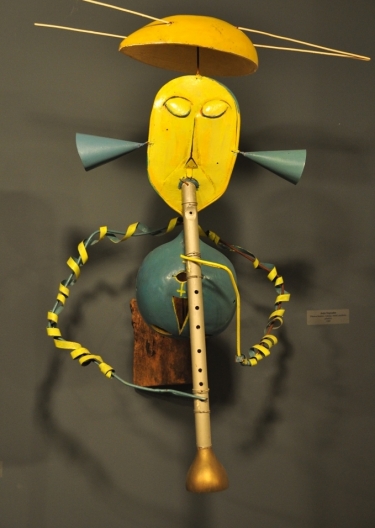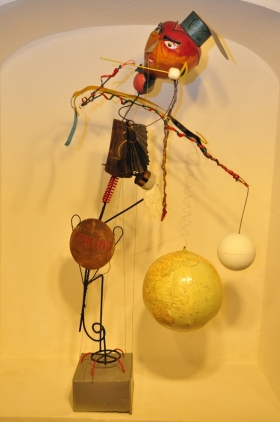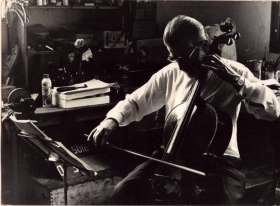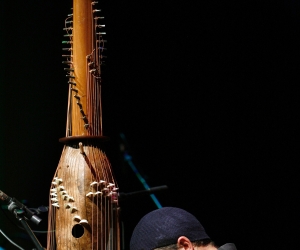In March 2014, I found myself facing the late Walter Smetak’s Pindorama, a seven-foot-two-inch-tall instrument installation comprising seven calabash gourds arranged in a diamond-like formation and resting on a bamboo pedestal. Dozens of clear plastic tubes with flute mouthpieces fixed at their ends hung from the gourds. Cowbells were suspended from the frame. Later, during a conversation about Smetak, Brazilian composer–performer Tuzé de Abreu told me that up to twenty-four musicians could play Pindorama at once. “When everybody plays the harmonics on the flutes, there is a sensation of the sun shining on water,” he said.
The day before, I knew nothing about Smetak.
I had travelled from the U.S. to Salvador da Bahia in Brazil to prepare a sound installation for the third Bienal da Bahia. At the recommendation of curator Ana Pato, I went to Galeria Solar Ferrão in the colonial Pelourinho district to see 150 of Smetak’s plásticas sonoras (sound sculptures). After my encounter with Pindorama, I stepped into the second gallery where I found a wall of stringed instruments made with calabash halves. Included were some that Smetak named the chori family—stringed instruments played with bows and having long fingerboards and small bodies in an unconventional, lute-like design. Chori Viola features a large calabash resonator, which is perched above the tuning pegs, dwarfing the main instrument body. Chori Sol e Lua (Sun and Moon) is built with two necks and two bodies joined at an angle, as if one instrument were growing out of another. A collection of chori bows hanging on the far wall appeared to be modelled after ancient hunting bows.
In the third and final gallery I found instruments that were still more strikingly original. Máquina do Silêncio is an elaborate machine comprising strings, gourd resonators, a musical pickup, and mechanical crank. The strings are arranged in a cylindrical formation. The tuning pegs are set in a crank-operated disc. An additional set of strings perches above in an hourglass formation. Halves of calabash gourds stand facing each other on top of the instrument. I later read Smetak’s note on Máquina do Silêncio in his book Simbologia Dos Instrumentos (symbology of instruments), written in 1980 and published in 2001: “An absurdity. Why not? Considered an absence of sound . . . referring to the interior conditions of psychic states.”
Also in the gallery were, among others, Gambus Orientalis, a viola de gamba with an upside-down body; Constelação, a painting of the night sky with playable strings connecting the stars; Amén, which resembles a stylized eye with a calabash as a retina; and Três Sóis, which has three vertical disks with playable spokes that produce optical effects when rotated, reminiscent of Marcel Duchamp’s Rotoreliefs.
Perhaps the most perplexing piece in the exhibit was
M-2005,
a sculpture of a man holding a suspended inflatable globe, which is outfitted with playable strings that run from the body to the pedestal. “THE END” is printed in large type on the spherical torso. Smetak wrote in his book: “M-2005 is a being floating on a block of ice, drifting from the North Pole southward, towards the Equator, to land on shore. A penguin with an innocent nature accompanies this being, whose name begins with the letter m . . .”
For certain plásticas sonoras, metaphysics and symbolism exceed musical function. The only musician to play on both of Smetak’s albums, De Abreu (whom I got to know during the months following our first meeting, and who became for this article a firsthand source of information about Smetak’s music and practice) told me that Smetak created eighty-nine instrumental families, and that eighteen of these include instruments with resonance that is felt but not heard: Anjo Soprador (blowing angel), Guerreiro (warrior), São Jorge Tibetano (Tibetan Saint George), Espaço e Nuvens (space and clouds), Cravo da Bahia (homage to Mario Cravo, a famous artist from Bahia), Andrógino (androgyne), Namorados Abstratos (abstract lovers), SOS Situação (SOS situation), Imprevisto (unforeseen), Frevo (a rhythm from northeast of Brazil), Olho Público (Public Eye), Metástase (metastasis), Fecundação Cósmica (cosmic fecundity), Três Cruzes (three crosses), Interregno (intermission), AK-ELA, Caossonancia (a neologism for a new cosmic order), and Incontemporalidade, or Zé Toca (no time, or play Joe).
echoes and influence
I left Brazil assuming that Smetak’s work had somehow previously escaped me, while my peers already knew of him. Back in the U.S., I questioned my colleagues Nicolas Collins, Stephen Vitiello, and other sonic artists having an encyclopedic knowledge of the practice: they, too, had never heard of Smetak. Aside from one article by de Abreu (translated into English), I found barely a trace of writing on Smetak in English. Within the Portuguese-speaking world, however, things were different. Smetak had influenced generations of musicians. Gilberto Gil, Caetano Veloso, Tom Zé, Tuzé de Abreu, and Marco Antônio Guimarães (leader of Uakti) all worked with Smetak at the Federal University of Bahia (UFBA). Uakti’s instruments (featured in its performances with Philip Glass, Paul Simon, and Stewart Copeland) were clearly inspired by Smetak. De Abreu—who worked with Gal Costa, Maria Bethânia, Chico Buarque, Carlinhos Brown, and Gil—was so close to Smetak that he was often called “son of Smetak.”
Tom Zé studied cello with Smetak at UFBA, and frequently acknowledges Smetak as a primary influence. Videos of Smetak and Zé conducting their respective ensembles in the 1970s look quite similar. Both are seated at an electronic organ and conduct musicians who play homemade instruments creating unconventional musical sounds.
Angolan-Portuguese composer and instrument-maker
Victor Gama has also mentioned Smetak as a precedent. Gama’s toha features multiple gourd-shaped resonators, cylindrical arrangements of strings, and multi-instrumentalist design—all elements pioneered by Smetak. Gama’s
pangeia instrumentos concept is also related to Smetak’s work. In
Simbologia Dos Instrumentos, Smetak refers to an ancient, mythical subterranean territory
, and relates how each of his designs is linked to esoteric spiritual practice. Gama’s work picks up on that of Smetak, adding digital components and slick, computer-based manufacturing technologies.
early journeys
Smetak was born in 1913 in Zurich, Switzerland, where he later studied cello and apprenticed in a luthier’s workshop learning to build and repair stringed instruments. He studied cello at the Mozarteum Academy in Salzburg, graduated from the New Conservatory of Vienna in Austria, and studied with master cellist Pablo Casals. Smetak moved to Brazil in 1937 to work as a professor and cello soloist. He helped start orchestras in Porto Alegre, Rio de Janeiro, and São Paulo. His career in symphonic, radio, and casino orchestras lasted about ten years and included engagements with iconic singer Carmen Miranda.
In 1946, Smetak met Henrique José de Sousa, leader of the Brazilian Theosophical Society (which evolved into the Brazilian Society of Eubiose), and was officially admitted into the society in 1949. De Abreu described the society to me as “a kind of mystical association that considers Brazil the centre of the world and uses many religious and mystical procedures from India.” After Smetak met de Souza, he left music, left his first wife, and studied with the first Eubiose group for eleven years, practising various kinds of yoga. “In 1957, he came to Bahia a different man—in clothing, thinking, and procedures—as a mystical person,” de Abreu told me.
THIS IS AN EXCERPT. TO READ THE FULL FEATURE ON WALTER SMETAK - WHICH INCLUDES COMMENTS FROM ARTO LINDSAY, THE STORY OF PROJECT OVO, AND A SIDEBAR ON SMETAK'S RECORDING RARITIES - SUBSCRIBE NOW OR ORDER THE ISSUE SEPARATELY.





